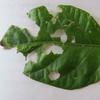Dear Reader, in this age of AI created content, please support with your goodwill someone who works harder to provide the human-made. Sign up in the righthand column or bottom of this page. You will receive my hand illustrated monthly newsletter RESTORE NATURE and access to the biodiversity garden design course as I write...and nothing else, I respect your time.
what to do about garden insects
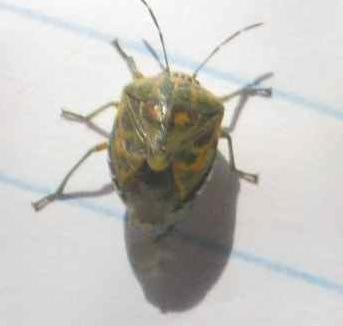
This appears to be a small green and brown tomato stinkbug. Combat measures below. Taken on 8.5mm lined writing paper
A huge diversity of garden insects has appeared this last month among my vegetables.
It is high summer and it is to be expected. We even have cicadas chirping at night for the first time, its been so warm in January. I have done some research on several of these insects to find out what to do, whether to go to war, or ignore. It is easy to find information on war because an industry is based on our fear of insects in the garden, but it took me many years to find that war is unnecessary.

the most destructive of garden insects: fruit fly with pupae
The first garden insects to be spotted were a lot of fruit fly larvae in the cucumbers. From the yellow spotted abdomen and wing markings of the adult flies, and the host preference for laying eggs, they may be pumpkin flies (Dacus sp.). After trying some organic control measures, we found hand pollination and then covering the cucumber ovary when it was very small in cheesecloth bags to be the most successful. See our six articles on organic fruit fly control, its life cycle, identification and more listed below. The control measures will work against a number of garden insects, like coddling moth.
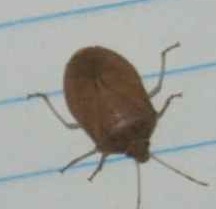
a pale brown stinkbug; this garden insect was found on chard
Other garden insects have been found on the plants. On our chard or ‘spinach’ as it is known in South Africa, we found a pale brown stink bug, which has been photographed and pictured above, and a larger, dark brown, patterned stinkbug, see below, but I was unable to find a visual match in Visser (2009) or Ellis and Bradley (1996) for either stinkbug, only that they belong the family Pentatomidae. For those of you in the colder global regions there is information on using eco friendly methods for protecting your home from overwintering stinkbugs by Amy from Sage Urban Homesteading.
A sick looking tomato fruit was covered with smaller green and brown patterned stinkbugs (see below). The foliage was also in poor shape. I assume it is a stinkbug because of the condition of the leaves and fruit it was found on, and because of the odor it gave off in the bottle, and the curious habit of very energetic flipping when it lands on its back, that the other stinkbugs also showed. Stinkbugs suck plant sap from leaves, fruit and other parts. To combat them naturally, the advice is to remove weeds which help them survive between crops, attract the adults of native parasitic wasps and flies by planting small flowered plants, and use pyrethrin only if you really have to.
From what I know now I would never do this. Even a natural poison kills unselectively. Pyrethrin will also kill bees, and all the harmless insects, and the useful carnivorous ones which attack the herbivores and keep their numbers down. If the plants are really healthy they will be less vulnerable to insect attack. You make your plants more healthy by improving your soil. Since my garden has been on a soil regenerative program, I've not been bothered by insects. I've also started protecting rather than harming 'my' insects. As you get older, you do get wiser, in some ways.
If you must remove them, hand collecting works for the larger, slower garden insects. It may not work for small stink bugs as these insects are energetic and run fast.
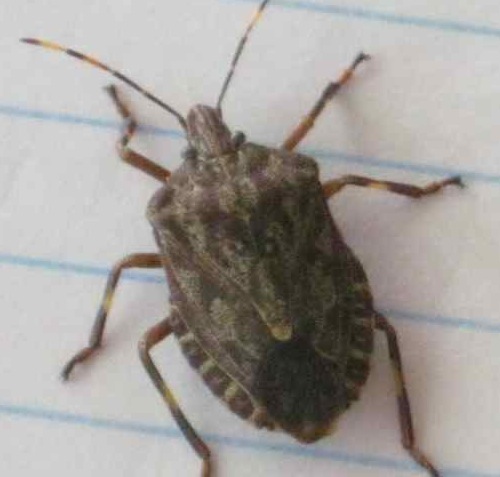
a gorgeously artistic brown stinkbug
The chilis and tomatoes had quite a few pattern-rich gold colored bugs. The specimen actually came off the Carolina Reaper, the most powerful chili in the world, which can measure 2.2 million capsicon units. Apparently only mammals can feel the burn in chilis and other animals are immune. These golden beetles may be tortoise beetles, although I couldn’t find a match in Visser (2009) I did find more information on the interesting genus Concyloctenia. The larvae have long spines, appearing like tiny hedgehogs, and keep a ‘tail’ of feces and castoff skin for camouflage. According to my mother (an Entomologist) the reflective gold color of the adults is distinctive among beetles. Tortoise beetles go for foliage, such as eggplant. They make numerous round holes in leaves when they eat. According to Ellis and Bradley (1996) tortoise beetles can be combated with pyrethrin. I wouldn’t recommend this as its also a danger to bees, like so many other organic insecticides. Home gardeners spraying pesticides are one of the reasons for the worldwide plummet in bee and other insect numbers and the loss of insect diversity. Visser (2009) says no control measures are needed. The beetles can be hand-picked in small gardens and on a larger scale, parasites and predators, of which they have a few, will take care of them.
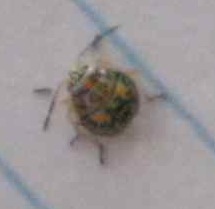 |
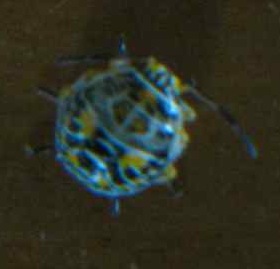 |
Concyloctenia ? another gorgeous bug, splashed with gold
My husband informs me that the tomatoes and chilies are also covered with green aphids. I have not bothered to photograph this common garden insect as I’m sure everyone knows them. There are about 40 aphid species which attack vegetables in South Africa. You can put out traps to monitor aphid levels in your crop, and monitor visually too. Some growers then spray when they are peaking, but I would urge you not to spray with one of the many insecticides designed for aphids. If you look at the soil of these growers, it is naked, with no mulch or ground cover, and that their plants are sickly is no wonder. Strengthen your soil with regenerative practices and your plants will be stronger. Aphids are known to attack weakened plants primarily.
Organic measures are the removal of weeds which allow the survival of aphids between crops, but are a bad idea for soil regeneration as the soil would then be bare. Still, the main stream urges that one should weed 2 weeks before planting and throughout season. The predators of aphids are lady beetles, lacewings, assassin bugs, predatory mirids and syrphid fly larvae. Some small wasps are also significant controllers of the population. Ant control may be effective as ants farm aphids, increasing their numbers. Monitor and see whether the aphids are being kept in check by predators. This is normally the case with regenerative practice.
Look for signs like hollowed out aphid mummies, brown diseased aphids and use insecticides only if your life depends on it and only when the natural predators fail and its really needed. In a small garden aphids can be hosed off plants and like many garden insects, sprayed with soapy water. However, the soapy water will also kill the beneficial insects. Do not plant downwind of an infestation as they are spread by the wind (Visser 2009). Soap spray dries out and kills soft bodied insects. Spray in spring and again when winged females appear and take care that the soap does not scorch your plants or kill beneficial garden insects (Ellis and Bradley: 1996).
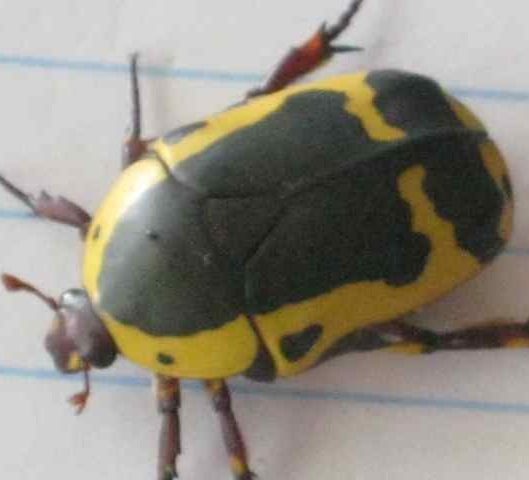
the king of food garden insects: Pachnoda sinuata, a fruit "chafer"
Every year our garden is full of large bumbling black and yellow beetles which feast on rotten guavas and acacia blossoms. We find their fat larvae in the compost, and sell them sometimes to fishermen. I found a visual match in Visser (2009) : Pachnoda sinuata, sub family Cetoniinae, family Scarabaeidae, Order Coleoptera, or true beetles, which have four wings, the top two being protective shields and the bottom two beneath, large folding membranous wings like fans. These beetles are big fruit eaters. Visser (2009) recommends hand collecting beetles as they feed on fallen fruit, or catch them in traps full of fruit, removing all fallen fruit, and harvest when unripe if possible. He warns against spraying as the fruit would be contaminated. As a linguistic student I was fascinated to find out that their common name ‘fruit chafer beetles’ does not come from their mouth parts chafing the fruit !! but from the old Germanic root common to English and German (the German for a beetle is Käfer) and that this old root has survived in English only in the common names of certain beetles !
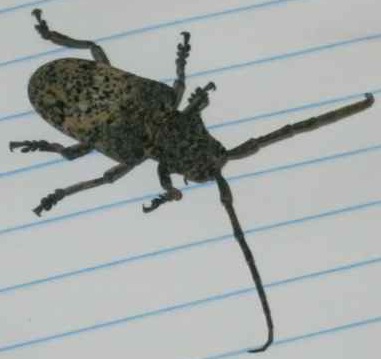
a huge, armoured bug. The closest identification being Hemiptera ?
We found a large warty bug with long luxurious feelers drowning in a water bucket and photographed it and released it in the front garden among the aloes and morning glory. I don’t know what it was doing in the bucket, but if it got stuck into our tomatoes I guess it would do damage, just from its size. It appears most strongly to resemble the group of ‘tip wilters’ genus Anoplocnemis or Leptoglossus in the family Coreidae in the order Hemiptera (sucking bugs) or even ‘bean bugs’ Clavignalia, but doesn’t look identical to any of the common South African Coreidae which are considered pests.
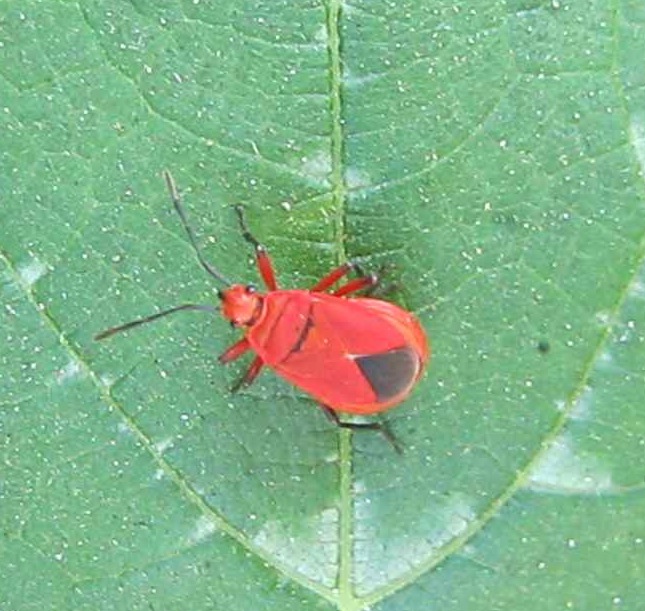 |
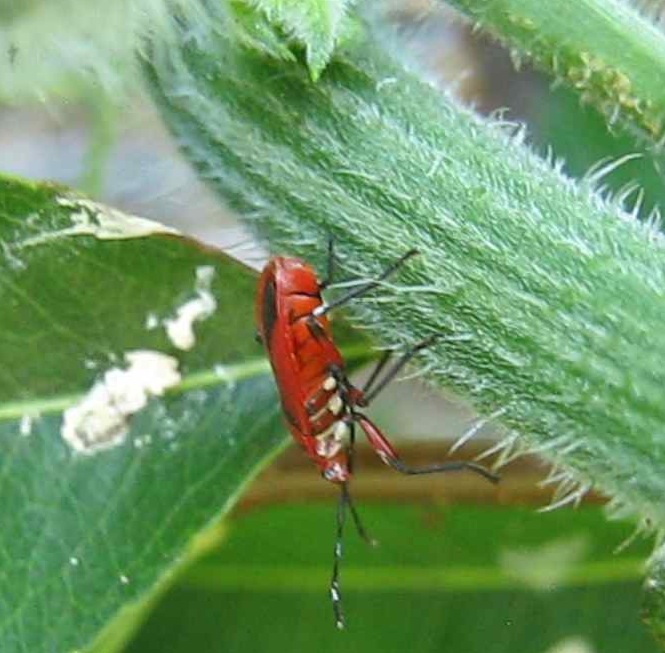 |
fire bugs or love bugs ? the ubiquitously ardent Cenaeus carnifex
We found these red bugs against sun drenched walls in the alley
and garden. They seemed to be on the cucumber vines and elsewhere in
vegetation. Similar looking insects are found in A complete guide to vegetable pests in South Africa (Visser, D.
2009). These were known as Milkweed bugs, of Genus Spilostethus, Haemobaphus, Graptostethus and Oncopeltus in the family Lygaeidae,
and suck sap from flowers, shoots, fruit, leaves and seeds, and are mainly
attracted to maize, sweet potato, potato and tomato. Visser (2009) claims
control is not necessary. I also found a very useful identification blog
online, as identifying garden insects can be crucial in their control: www.ispotnature.org. Online,
similar looking insects were referred to as cotton stainers (genus Dysdercus) but they were very dark in
colour, more brown than red. Others were referred to as red bugs or fire bugs, and they resembled my specimens most closely. They are Cenaeus carnifex, family Pyrrhocoridae, order Hemiptera.
They undergo incomplete metamorphosis (meaning they look similar at different
stages and sizes, but only adults are winged). Red with 2 triangular black
markings on the back, they are generally 10-11mm in length by 3-4mm in width.
Online records show numerous sighting of this common garden insect in Cape at Noordhoek, Lambert’s bay and other locales. Nearly all observers note that they are mating most of the time (see photo by the well known botanist Tony Rebelo on pinterest). According to an observer in India, they are commonly seen all over the world in lush vegetation, and believed to be of African origin. I did not find them mentioned in Ellis and Bradley (1996) so they either have not yet reached Pennsylvania, or it is too chilly for them.
The South African authors did not think they needed control measures, but the writer from India was concerned. Perhaps they have enough natural predators to keep down their numbers here, if they are native to this region of Africa. Possible future biological controls mentioned are that they are host species to a parasitic protozoa which inhabits their salivary glands. These are of the species Chagasella ganaptii and C. hartmanni, and have been recorded in arthropods, namely Amitermes (a genus of termites) and Cenaeus carnifex (our firebug).


one of the mysterious black bugs sitting among some mustard seed husks
I found masses of these small black bugs (3 to 8mm in length) on the mustard bush, inside the paper bags covering my ripening black mustard seeds. I am still trying for some kind of identification. It looks like none of the images I found on the net. It looks close to the black corsair bug (see my pinterest page below), a type of assassin bug, but it isn't close enough, nor does it look like some of the more slender stink bugs or a capsid. Notable it has white bands on the tips of its long feelers, black joints on its long slender legs, has distinct thorax, and is not a scarab like beetle, and its abdomen is flat, especially on top. The edge of the abdomen appears to have a rim with a pale grey pattern.
They appear to be able to fly, but scurry rapidly about on their long legs even up the vertical glass wall of a jar without a problem, something I don't see very often. The mouth-parts and head appear pointed and its eyes are not large, but protrude out of the sides of its head like small beads. They are very oxygen dependent, and settle into torpidity until I blow air into the bottle, at which they all come alive as if electrified. If they are predatory beetles they are a gift to the garden, as they will keep other insects in check.
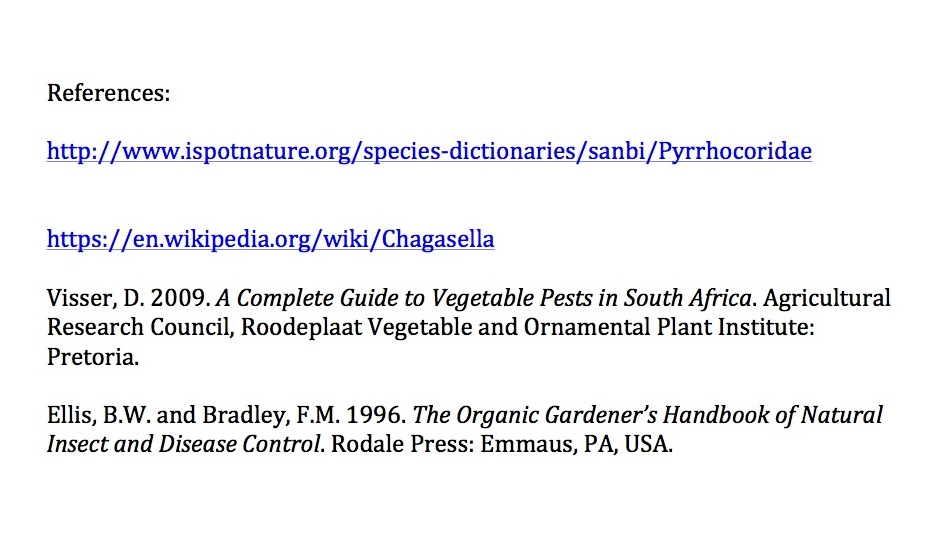
------
home page for linking up to eco sensitive gardening inspiration
------
------
------
------
fruit fly life cycle and control measures
You’re a home gardener ! Share your experiences and questions !
We all know about home gardening. Tell us about your successes, challenges and ask about issues that bother you. You may have the luxury of a back garden, but there are other ways we learn. Few people age without growing something or buying vegetables during their lives ! It is absolutely guaranteed that you have learned things which can help others on their gardening journey.
We invite you to share your stories, ask questions, because if a thing has bothered you it will bother others too. Someone may have a solution ! No question is too small. There is learning for everyone involved, for you, for me (yes, I learn from every question), for us all. Exciting stuff !
We are starting on a new journey. Every week we will profile your letters ! The best stories and questions we receive.
What Other Visitors Have Said
Click below to see contributions from other visitors to this page...
Who has been munching on my Carolina Reaper ? 




Dear Caroline
Today I found this severely chewed leaf on my Carolina Reaper, the hottest chili in the world. Which insect could have done this, and …
bugsy M ? 




Hi Caroline
I found these perfect round holes in the leaf of a chili plant. What causes them ?
Is it a gun toting garden denizen doing target practice …
Restore Nature Newsletter
I've been writing for four years now and I would love to hear from you
Please let me know if you have any questions, comments or stories to share on gardening, permaculture, regenerative agriculture, food forests, natural gardening, do nothing gardening, observations about pests and diseases, foraging, dealing with and using weeds constructively, composting and going offgrid.
SEARCH
Order the Kindle E-book for the SPECIAL PRICE of only
Prices valid till 30.09.2023
Recent Articles
-
Geography Research Task
Jan 31, 25 11:37 PM
To whom it may concern My name is Tanyaradzwa Madziwa and I am a matric student at Springfield Convent School. As part of our geography syllabus for this -
Eco Long Drop Pit Latrines Uganda
Nov 29, 24 02:45 AM
Good evening from the UK. My name is Murray Kirkham and I am the chairman of the International and foundation committee of my local Lindum Lincoln Rotary -
Landscape Architect
Oct 01, 24 10:42 AM
I so appreciate your informative description! Your experimentation and curiosity with the seeds, germination, and rearing of the maggot are exciting to
"How to start a profitable worm business on a shoestring budget
Order a printed copy from "Amazon" at the SPECIAL PRICE of only
or a digital version from the "Kindle" store at the SPECIAL PRICE of only
Prices valid till 30.09.2023
